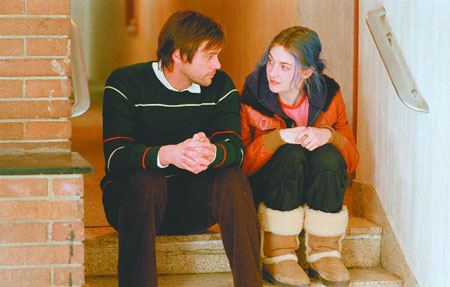Carrey and Winslet so deeply in love even mind-altering science can’t save them
Following his critically acclaimed debut movie, “Being John Malkovich,” the sophomore slump kicked in for screenwriter Charlie Kaufman. “Human Nature” (directed by Michel Gondry), “Adaptation” (directed by Spike Jonze), and “Confessions of a Dangerous Mind” (George Clooney’s directorial debut, based on the allegedly factual memoirs of “Gong Show” host Chuck Barris’ career as a CIA hit man) were clever, but a bit soulless. In particular, “Adaptation” wittily depicted creative frustration only to wind up in a self-referential hall of mirrors. “Eternal Sunshine of the Spotless Mind,” also directed by Gondry, changes all that, in a story that has a lot of heart. “Eternal Sunshine” brings to mind the work of French director Alain Resnais, perhaps best known for his 1955 Holocaust documentary “Night and Fog.” Kaufman and Gondry’s film shares Resnais’ fascination with the byways of memory and the infinite possibilities of the editing room.
Resnais’ subjects included some of the 20th century’s major tragedies. “Eternal Sunshine” has a far more limited set of interests, but those include the willingness to dig deep into reverie, even at the risk of narrative confusion. Joel (Jim Carrey) and Clementine (Kate Winslet) meet twice, first before the opening credits, the second time well into the film. Depressed about Valentine’s Day coming up, Joel takes the Long Island Rail Road out to Montauk. There he meets a blue-haired woman, Clementine, in a coffee shop. She makes the first move, striking up a conversation on the train back. They wind up going home together.
Joel’s friend shows him a card from a company called Lacuna, Inc., but requests that Joel not mention his name to Clementine. We learn that both Clementine and Joel were customers, the company, which erases one’s memories of a particular person.
Joel’s and Clementine’s relationship forms the prologue and epilogue to the film’s real meat: the night in which Joel’s memories are wiped from his mind, while technicians from Lacuna drink beer, smoke pot, and dance in their underwear. This non-narrative sequence lasts about an hour. In it, Joel decides that he wants to remember Clementine after all. He recalls happy times, but arguments and tense moments pop up as well. Their attraction to each other is obvious, but so are the reasons they couldn’t stay together.
Clementine keeps recurring in Joel’s memories, even when he recalls his childhood. The love story’s details are gradually filled in, often through repetition. Time is as fluid as water, a frequent image in the film. This approach perfectly captures Joel’s hallucinatory agitation.
Gondry’s reputation rests far more on his music videos than on “Human Nature.” He’s shown a gift for technical gimmickry, both low-tech and computer-generated––the Lego animation of the rock band White Stripes’ “Fell In Love With A Girl,” the kaleidoscopic perspectives of the Chemical Brothers’ “Let Forever Be,” to name a few examples––as well as a delight in kinetic motion. His video for Daft Punk’s “Around The World” is as exhilarating as any musical number from “Singing in the Rain” or Busby Berkeley movies.
“Eternal Sunshine” tones down the visual flash, but it shares the director’s anti-realist delight in manipulating imagery. In this case, Gondry subtracts: in Joel’s dream, objects and people keep disappearing. In his videos, such images are usually joyful, but here, Gondry makes them terrifying.
He and Carrey have a knack for capturing low-level depression. Carrey’s acting hasn’t particularly impressed me since he decided that he wanted to get serious and prove that he wasn’t simply a clown. (His choice of projects hasn’t helped.) But here he gives a subdued performance here that eschews shtick and Oscar-baiting self-consciousness.
Ellen Kuras’ cinematography captures the chill of a New York winter. A technician aptly describes Joel’s apartment as a stale-smelling dump. Kuras and Gondry make sure that one can almost smell the dirty laundry. The deliberate dinginess of the opening scenes makes way for a brighter palette to match the wider range of settings in the movie’s central section.
“Eternal Sunshine” is science fiction without the usual bells and whistles. The technology behind Lacuna is taken for granted, and it addresses one of the genre’s frequent questions. What would happen if one could travel back in time? Not physically, in this case, but mentally. Joel and Clementine were meant to be together––and meant to come apart. Trying to change the course of time is a fool’s game.
“Eternal Sunshine” wrings pathos out of their troubled relationship, winding down into a melancholy affirmation of fate. Joel and Clementine are happy for the moment, but it’s anyone’s guess how long that will last. Nevertheless, that rush of joy and discovery is enough to justify all the pain they put themselves through.


































